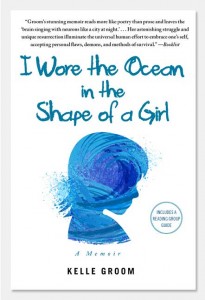 Memories aren’t linear. Shame doesn’t subside with each confession. That is the world inside Kelle Groom’s memoir, I Wore the Ocean in the Shape of a Girl. It could be considered a fragmented diary, an addiction tell-all, or a poet’s gloss on agonizing life events. Kelle Groom, an accomplished poet, skillfully takes painful moments of her past and crafts them into a stunning narrative.
Memories aren’t linear. Shame doesn’t subside with each confession. That is the world inside Kelle Groom’s memoir, I Wore the Ocean in the Shape of a Girl. It could be considered a fragmented diary, an addiction tell-all, or a poet’s gloss on agonizing life events. Kelle Groom, an accomplished poet, skillfully takes painful moments of her past and crafts them into a stunning narrative.
I Wore the Ocean in the Shape of a Girl is the story of a woman who gives her infant son up for adoption to her aunt and uncle. Her child dies of cancer before he makes it halfway through his second year of life, a life she is not a part of, except in imagination and later artifacts and mementos. Her time before her son’s birth and after is spent on the edge of life—drinking, sleeping around, attempting sobriety, working, going to college, yet never quite finding her place and remaining distant—the anchor throughout all of it is her writing where she is at home with herself.
Though the memoir is not specifically crafted from Grooms’ actual journals (she tried that and it didn’t gel), she writes with an immediacy that is entrancing and intimate. Throughout an objective presentation, with an almost detached voice, the poet in her arrives to lift stark moments toward reverence for what she survived. In the chapter, “El Paso,” Groom thinks of one of her childhood memories, and connects it to her infant son’s death, “I wonder if what killed him was my silence. All that falling backward into myself, unable to face anger, annoyance. Unable to try. Here, take it, my voice, my life, my child, here, take it.”
Central to Groom’s memoir are relationships and how those family, friends, co-workers, teachers, lovers, and one-night stands impacted her life. While Groom’s memoir is essentially linear, she uses a non-linear technique within individual chapters to create links between the past and present. In one paragraph Groom speaks of someone in the past, then in the next few paragraphs she shifts to the present, and then shifts to a correlated memory in a stream-of-consciousness style. It can be disorienting, but overall faithfully recreates those moments of self-reflection when memories are woven together in disjointed attempts to manage with past events that cannot be undone.
Who willingly looks at their life’s fractured trajectory without assistance? For some, assistance is in the form of therapy, addiction, or denial, but for writers it’s through language. After Groom deals with a cancer scare in her 40s, she links that sequence of events to a walk she took in the middle of the night: “The blue mountains were the same color as the night, light came from the stars and little roadside lanterns to my left. To my right, I felt the presence of a live being moving. It was two horses, hurrying to walk beside me, two dark horses keeping me company on their side of the fence.” Throughout the memoir she grounds true events and harsh realities by tethering them to lucid, poetic images.
In the hands of a skillful writer, shame and memory fuse through lyrical, raw narrative. Groom’s compulsion to elevate shame and memory into art will stir those who’ve struggled to do the same. Those who have endured the cycle of addiction and sobriety will connect to Groom’s decades-long struggle. Readers who are also writers will enjoy Groom’s memoir the most. They will sympathize with Groom’s reliance on language to transform her sorrow into self-acceptance.
Rating: 5 of 5 stars



This poetic memoir is amazing. I couldn’t put it down. Kelle is a brilliant writer and lovely human being. I love her, this memoir and her books of poetry also.
This remains my favorite memoir of recent time. Kelle is a gorgeous writer and this book is unbelievable.